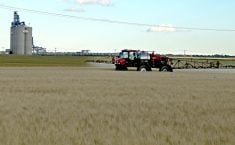The potentially negative impact of this year’s crop disaster on grain handling giant Viterra could be offset by good farming weather 15,000 thousand kilometres away.
In South Australia, farmers along with Viterra’s Australian grain operations, are gearing up for a good seeding season. Viterra’s operations are concentrated in that state.
“Our South Australia business … is experiencing good seeding conditions and sufficient moisture, a positive signal for crop development from that area,” said Bob Miller, Viterra’s senior vice-president of North American grain.
Read Also

New coal mine proposal met with old concerns
A smaller version of the previously rejected Grassy Mountain coal mine project in Crowsnest Pass is back on the table, and the Livingstone Landowners Group continues to voice concerns about the environmental risks.
Luke Mathew, a commodity strategist with Commonwealth Bank of Australia, echoed that view.
“It’s the best start to a cropping campaign in eastern Australia for at least five years,” he said in a recent commentary.
Australian market watchers are forecasting a 2010-11 Aussie wheat crop of around 22 million tonnes, up from 21.7 million the previous year and well above the five-year average of 18.3 million, which includes two drought years.
Last year, Viterra purchased ABB Ltd., one of Australia’s leading agribusinesses. One of the benefits of the deal touted by Viterra at the time was that it would minimize the risks associated with crop failure in either country.
Miller said the benefits of that approach are being borne out this year.
“Our strategy to diversify into the southern hemisphere mitigates our risk and could pay off this year, as it will lessen the impact, to some degree, of the effects of weather conditions in North America,” said Miller.
In a July 8 news release, Viterra estimated seeded acreage in Western Canada will be in the range of 50 to 52 million acres, compared with the five-year average of 60 million.
Statistics Canada will release its seeded acreage estimate on Aug. 20.
Viterra is also projecting 2010 production of the six major grains at 42 to 44 million tonnes, well below the average of 49 to 50 million tonnes.
The company said several factors could work in its favour.
There is a potential for good revenues from Australia, there are sizable on-farm carryover stocks in Western Canada, and there is the potential for strong yields on the land that did get seeded.
Viterra estimates that eight million acres in Western Canada went unseeded this spring and an additional two million acres were abandoned after seeding due to excess moisture.
That reduced acreage translates into lower demand for agricultural inputs, particularly fertilizer and chemicals. Viterra projects industry-wide input sales will decline by 15 to 17 percent.
The financial impact of unseeded acreage and lower crop input sales will show up in Viterra’s third quarter results (the three-month period ending July 31).
Doug Wonnacott, senior vice-president of agri-products, said the year could be helped by a strong fall, if there are good harvest conditions and farmers are able to engage in post-harvest field work.
“Full year results will be dependent on fall field activity,” he said. The fiscal year ends Oct. 31.
He said farmers might want to maximize their application of fertilizer, given the loss of nitrogen that results from excess moisture.
“Additionally, we expect significant weed growth, which will require the application of herbicides in the fall to prepare the land for the following (spring) growing season,” said Wonnacott.
Australian wheat output:
•2010-11 -21.6 million tonnes (forecast)
•2009-10 -21.7 million tonnes
•2008-09 -20.9 million tonnes
•2007-08 -13.0 million tonnes
•2006-07 -10.6 million tonnes
•2005-06 -25.2 million tonnes
















